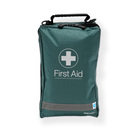Introduction to the Human Body
Unlock This Video Now for FREE
This video is normally available to paying customers.
You may unlock this video for FREE. Enter your email address for instant access AND to receive ongoing updates and special discounts related to this topic.
Understanding Body Systems
Introduction
Prior to discussing methods of assistance, let's briefly explore the body's systems. Acquiring knowledge of bodily functions enhances comprehension of procedural interventions. The human body operates through intricate systems, warranting further study for a comprehensive grasp.
Additional Resources
Extensive literature is available to delve deeper into physiological mechanisms. Access relevant materials through the provided download links in this course.
Exploring Body Systems
Various videos in this section elucidate distinct body systems. While not part of practical sessions or subject to testing, understanding these systems enriches your caregiving expertise.
_-Trauma_8x20_CE.jpg)






